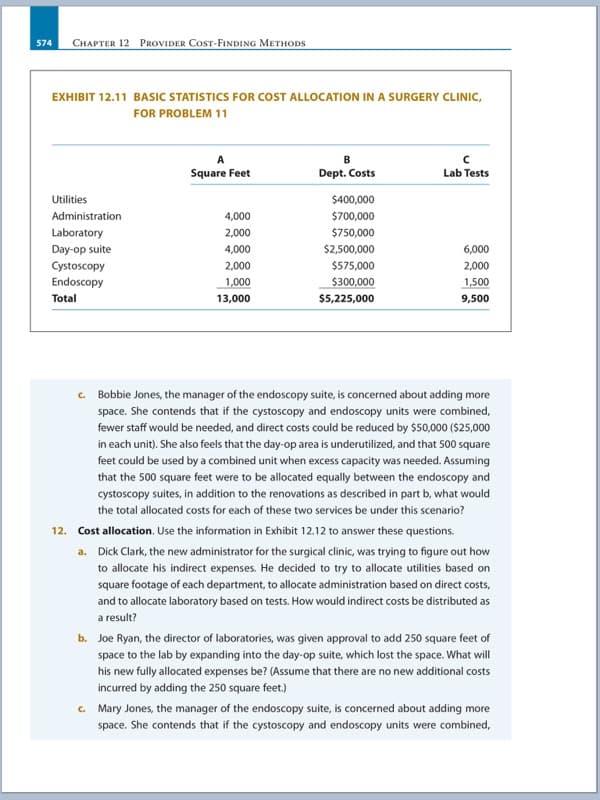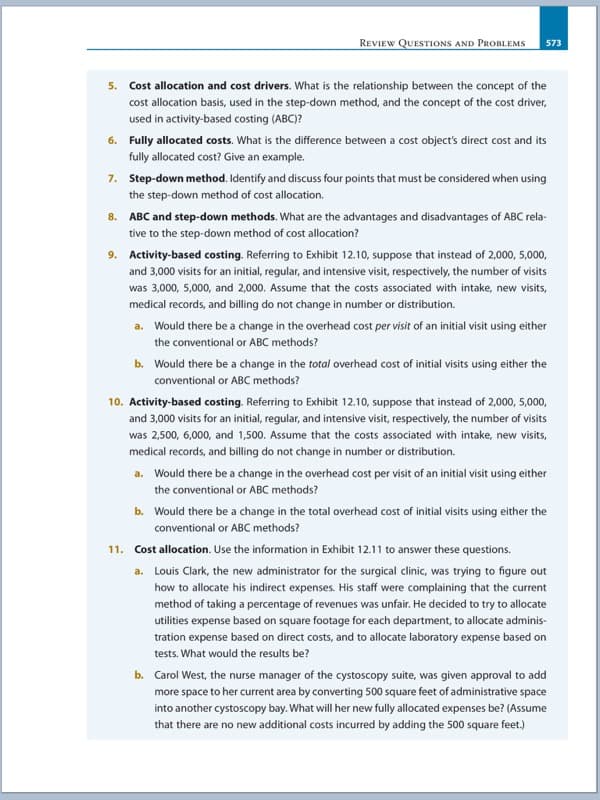Cost allocation. Use the information in Exhibit 12.11 to answer these questions. a. Louis Clark, the new administrator for the surgical clinic, was trying to figure out how to allocate his indirect expenses. His staff were complaining that the current method of taking a percentage of revenues was unfair. He decided to try to allocate utilities expense based on square footage for each department, to allocate adminis- tration expense based on direct costs, and to allocate laboratory expense based on tests. What would the results be? b. Carol West, the nurse manager of the cystoscopy suite, was given approval to add more space to her current area by converting 500 square feet of administrative space into another cystoscopy bay. What will her new fully allocated expenses be? (Assume that there are no new additional costs incurred by adding the 500 square feet.)
Cost allocation. Use the information in Exhibit 12.11 to answer these questions. a. Louis Clark, the new administrator for the surgical clinic, was trying to figure out how to allocate his indirect expenses. His staff were complaining that the current method of taking a percentage of revenues was unfair. He decided to try to allocate utilities expense based on square footage for each department, to allocate adminis- tration expense based on direct costs, and to allocate laboratory expense based on tests. What would the results be? b. Carol West, the nurse manager of the cystoscopy suite, was given approval to add more space to her current area by converting 500 square feet of administrative space into another cystoscopy bay. What will her new fully allocated expenses be? (Assume that there are no new additional costs incurred by adding the 500 square feet.)
Chapter6: Activity-based, Variable, And Absorption Costing
Section: Chapter Questions
Problem 12MC: Which statement is correct? A. Activity-based cost systems are less costly than traditional cost...
Related questions
Question
100%
Need help answering question 11 regarding cost allocation

Transcribed Image Text:CHAPTER 12 PROVIDER CoST-FINDING METHODS
574
EXHIBIT 12.11 BASIC STATISTICS FOR COST ALLOCATION IN A SURGERY CLINIC,
FOR PROBLEM 11
Square Feet
Dept. Costs
Lab Tests
Utilities
$400,000
Administration
4,000
$700,000
Laboratory
2,000
$750,000
Day-op suite
4,000
$2,500,000
6,000
Cystoscopy
Endoscopy
2,000
$575,000
2,000
1,000
$300,000
1,500
Total
13,000
$5,225,000
9,500
c. Bobbie Jones, the manager of the endoscopy suite, is concerned about adding more
space. She contends that if the cystoscopy and endoscopy units were combined,
fewer staff would be needed, and direct costs could be reduced by $50,000 ($25,000
in each unit). She also feels that the day-op area is underutilized, and that 500 square
feet could be used by a combined unit when excess capacity was needed. Assuming
that the 500 square feet were to be allocated equally between the endoscopy and
cystoscopy suites, in addition to the renovations as described in part b, what would
the total allocated costs for each of these two services be under this scenario?
12. Cost allocation. Use the information in Exhibit 12.12 to answer these questions.
a. Dick Clark, the new administrator for the surgical clinic, was trying to figure out how
to allocate his indirect expenses. He decided to try to allocate utilities based on
square footage of each department, to allocate administration based on direct costs,
and to allocate laboratory based on tests. How would indirect costs be distributed as
a result?
b. Joe Ryan, the director of laboratories, was given approval to add 250 square feet of
space to the lab by expanding into the day-op suite, which lost the space. What will
his new fully allocated expenses be? (Assume that there are no new additional costs
incurred by adding the 250 square feet.)
c. Mary Jones, the manager of the endoscopy suite, is concerned about adding more
space. She contends that if the cystoscopy and endoscopy units were combined,

Transcribed Image Text:REVIEW QUESTIONS AND PROBLEMS
573
5. Cost allocation and cost drivers. What is the relationship between the concept of the
cost allocation basis, used in the step-down method, and the concept of the cost driver,
used in activity-based costing (ABC)?
6. Fully allocated costs. What is the difference between a cost object's direct cost and its
fully allocated cost? Give an example.
7. Step-down method. Identify and discuss four points that must be considered when using
the step-down method of cost allocation.
8. ABC and step-down methods. What are the advantages and disadvantages of ABC rela-
tive to the step-down method of cost allocation?
9. Activity-based costing. Referring to Exhibit 12.10, suppose that instead of 2,000, 5,000,
and 3,000 visits for an initial, regular, and intensive visit, respectively, the number of visits
was 3,000, 5,000, and 2,000. Assume that the costs associated with intake, new visits,
medical records, and billing do not change in number or distribution.
a. Would there be a change in the overhead cost per visit of an initial visit using either
the conventional or ABC methods?
b. Would there be a change in the total overhead cost of initial visits using either the
conventional or ABC methods?
10. Activity-based costing. Referring to Exhibit 12.10, suppose that instead of 2,000, 5,000,
and 3,000 visits for an initial, regular, and intensive visit, respectively, the number of visits
was 2,500, 6,000, and 1,500. Assume that the costs associated with intake, new visits,
medical records, and billing do not change in number or distribution.
a. Would there be a change in the overhead cost per visit of an initial visit using either
the conventional or ABC methods?
b. Would there be a change in the total overhead cost of initial visits using either the
conventional or ABC methods?
11. Cost allocation. Use the information in Exhibit 12.11 to answer these questions.
a. Louis Clark, the new administrator for the surgical clinic, was trying to figure out
how to allocate his indirect expenses. His staff were complaining that the current
method of taking a percentage of revenues was unfair. He decided to try to allocate
utilities expense based on square footage for each department, to allocate adminis-
tration expense based on direct costs, and to allocate laboratory expense based on
tests. What would the results be?
b. Carol West, the nurse manager of the cystoscopy suite, was given approval to add
more space to her current area by converting 5s00 square feet of administrative space
into another cystoscopy bay. What will her new fully allocated expenses be? (Assume
that there are no new additional costs incurred by adding the 500 square feet.)
Expert Solution
This question has been solved!
Explore an expertly crafted, step-by-step solution for a thorough understanding of key concepts.
This is a popular solution!
Trending now
This is a popular solution!
Step by step
Solved in 4 steps with 9 images

Knowledge Booster
Learn more about
Need a deep-dive on the concept behind this application? Look no further. Learn more about this topic, accounting and related others by exploring similar questions and additional content below.Recommended textbooks for you

Principles of Accounting Volume 2
Accounting
ISBN:
9781947172609
Author:
OpenStax
Publisher:
OpenStax College

Managerial Accounting: The Cornerstone of Busines…
Accounting
ISBN:
9781337115773
Author:
Maryanne M. Mowen, Don R. Hansen, Dan L. Heitger
Publisher:
Cengage Learning

Cornerstones of Cost Management (Cornerstones Ser…
Accounting
ISBN:
9781305970663
Author:
Don R. Hansen, Maryanne M. Mowen
Publisher:
Cengage Learning

Principles of Accounting Volume 2
Accounting
ISBN:
9781947172609
Author:
OpenStax
Publisher:
OpenStax College

Managerial Accounting: The Cornerstone of Busines…
Accounting
ISBN:
9781337115773
Author:
Maryanne M. Mowen, Don R. Hansen, Dan L. Heitger
Publisher:
Cengage Learning

Cornerstones of Cost Management (Cornerstones Ser…
Accounting
ISBN:
9781305970663
Author:
Don R. Hansen, Maryanne M. Mowen
Publisher:
Cengage Learning

Managerial Accounting
Accounting
ISBN:
9781337912020
Author:
Carl Warren, Ph.d. Cma William B. Tayler
Publisher:
South-Western College Pub

Financial & Managerial Accounting
Accounting
ISBN:
9781337119207
Author:
Carl Warren, James M. Reeve, Jonathan Duchac
Publisher:
Cengage Learning

Principles of Cost Accounting
Accounting
ISBN:
9781305087408
Author:
Edward J. Vanderbeck, Maria R. Mitchell
Publisher:
Cengage Learning